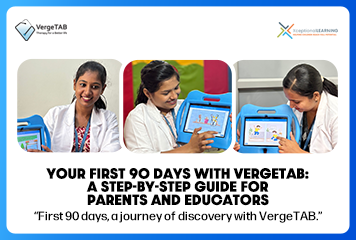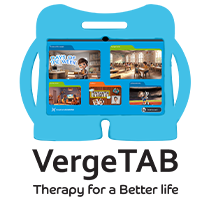Your First 90 Days with VergeTAB: A Step-by-Step Guide for Parents and Educators
10 Oct 2025

When parents and educators introduce new digital tools like VergeTAB into a child’s learning and therapy routine, the first 90 days are crucial. This period sets the foundation for comfort, engagement, skill development, and eventually independent use. Designed to support children with developmental delays, learning differences, and special needs, VergeTAB offers a structured, engaging, and personalized approach to therapy.
This guide will walk you through a step-by-step 90-day plan, broken into three phases, to ensure that children maximize the benefits of VergeTAB while building real, measurable skills.
Understanding VergeTAB
What is VergeTAB?
VergeTAB is an interactive learning device tailored for children with special needs. It combines the power of the XceptionalLEARNING platform with a child-friendly interface to deliver personalized therapy sessions. The device is equipped with:
- 10.1″ Full HD Display: Ensures clear visuals for engaging activities.
- 4GB RAM & 64GB Storage: Provides ample space for various applications and content.
- Expandable Storage: Supports up to 512GB via microSD for extensive content storage.
- Dual Cameras: Facilitates interactive sessions and assessments.
- Durable Build: Designed to withstand the rigors of daily use.
Key Features
- Personalized Learning Paths: Tailors activities to the child’s pace and learning style.
- Engaging Therapy Tools: Incorporates interactive games, visual aids, and animations.
- Progress Tracking with XceptionalLEARNING Dashboard: Get updates and detailed reports to personalize learning.
- Sensory-Friendly Experience: Provides customizable settings to accommodate sensory sensitivities.
- Seamless Integration into Daily Life: Aligns routines and schedules with daily activities.
Phase 1: Days 1–30: Introduction and Familiarization
Goal: Build comfort, trust, and curiosity while establishing a structured routine.
Key Objectives
- Develop familiarity with the device and its interface.
- Introduce basic skills without confusing the child.
- Begin creating a consistent daily learning/therapy habit.
Week-by-Week Plan
Week 1: Exploration and Comfort
- Let the child hold, touch, and explore VergeTAB freely.
- Introduce gestures: tapping, swiping, and dragging.
- Observe colours, sounds, or animations that capture attention.
- Explore menus, icons, and simple games together.
Week 2: Basic Cognitive Foundations
- Attention & Focus: Matching games (colours, animals, objects), short visual scanning exercises.
- Memory: Start with 3-item recall, repeat-and-find games.
Week 3: Motor Skill Introduction
- Fine Motor: Tracing shapes and letters, tapping targets.
- Hand-Eye Coordination: Dragging items into categories, simple alignment puzzles.
Week 4: Routine & Reinforcement
- Build 15–20-minute daily sessions at a fixed time.
- Track baseline performance: focus duration, accuracy.
- Use rewards: stars, stickers, and encouraging words.
Parental & Educator Tips
- Stay nearby to guide but not control.
- Focus on fun and exploration, not achievement.
- Keep sessions short, ending before frustration builds.
Phase 2: Days 31–60: Skill Development and Engagement
Goal: Expand cognitive, language, motor, and social-emotional skills.
Key Objectives
- Increase task complexity step by step.
- Encourage early signs of independence.
- Strengthen academic readiness and social-emotional learning.
Week-by-Week Plan
Week 5: Sequencing & Categorization
- Arrange objects by colour, shape, or function.
- Introduce daily routine sequences.
- Builds cognitive organization and logical thinking.
Week 6: Multi-Step Instructions
- Follow 2–3 step tasks.
- Example: “Pick red, then tap square, then drag to the box.”
- Strengthens working memory and task completion skills.
Week 7: Pattern Recognition
- Recognize and continue sequences (numbers, colours, shapes).
- Introduce logic-based pattern challenges.
Week 8: Social-Emotional Skills
- Emotion recognition: happy, sad, angry, surprised.
- Turn-taking games and impulse control exercises.
- Builds self-regulation and empathy.
Parental & Educator Tips
- Increase sessions to 25–30 minutes if focus allows.
- Discuss activities after completion: “What did you like?” “What was tricky?”
- Use XceptionalLEARNING charts to track growth.
Phase 3: Days 61–90: Mastery, Independence, and Real-Life Application
Goal: Build independence, reinforce mastery, and connect digital learning with real-world situations.
Key Objectives
- Strengthen higher-level thinking and problem-solving.
- Encourage self-regulated and independent use.
- Integrate skills into daily life and academics.
Week-by-Week Plan
Week 9: Problem Solving
- Simple logic puzzles, cause-and-effect activities.
- Encourage critical thinking and exploration.
Week 10: Academic Skills
- Counting, addition, and subtraction challenges.
- Measurement tasks: compare lengths, weights, volumes.
- Prepares for school readiness.
Week 11: Abstract Thinking
- Symbolic representation, categorization challenges.
- Encourages conceptual reasoning and flexible thinking.
Week 12: STEM & Life Skills
- Simple experiments (mixing colours, plant growth simulations).
- Nature observation: animal sounds, environmental modules.
- Daily routine planning: brushing teeth, packing bag, following schedules.
Week 13: Review & Independence
- Revisit challenging modules to ensure mastery.
- Self-directed sessions: child chooses activities and completes them independently.
- Track progress across cognitive, motor, language, and social-emotional skills.
Parental & Educator Tips
- Reduce supervision gradually—let the child lead.
- Celebrate independence: give praise for “doing it alone.”
- Use reports to plan whether the next focus is academics, therapy, or life skills.
Tracking Progress and Adjusting Goals
Throughout the 90 days, it is crucial to monitor the child’s progress and adjust goals accordingly. Utilize the following strategies:
- Regular Assessments: Conduct weekly evaluations to assess skill development.
- Adjust Learning Paths: Modify activities to align with the child’s evolving needs.
- Collaborate with Therapists: Share progress reports with therapists to ensure a cohesive approach.
Why This 90-Day Roadmap Works
- Consistency: Daily short sessions build lasting habits.
- Gradual Skill Building: Each week builds on the previous without overwhelming the child.
- Holistic Growth: Cognitive, motor, social, and academic skills are developed together.
- Parent-Child Bonding: Shared sessions strengthen relationships.
- Real-Life Application: Skills transfer from digital to everyday activities.
In conclusion, the first 90 days with VergeTAB are not just about learning how to use a device—it’s about building the foundation for growth, independence, and lifelong skills. By following this structured roadmap, parents and educators can ensure children develop focus, communication, problem-solving, and emotional regulation in a supportive, step-by-step way. VergeTAB transforms screen time into skill time, helping children progress confidently at their own pace.
For more details, contact us to explore the Best Therapy Services with Tab, our innovative Digital Therapy Activity Device, and how we support Early Detection and Intense Therapy Services for children.
For more insights, explore our blogs and videos to learn how interactive therapy transforms learning, see real-life success stories, and discover practical strategies for parents and educators.


